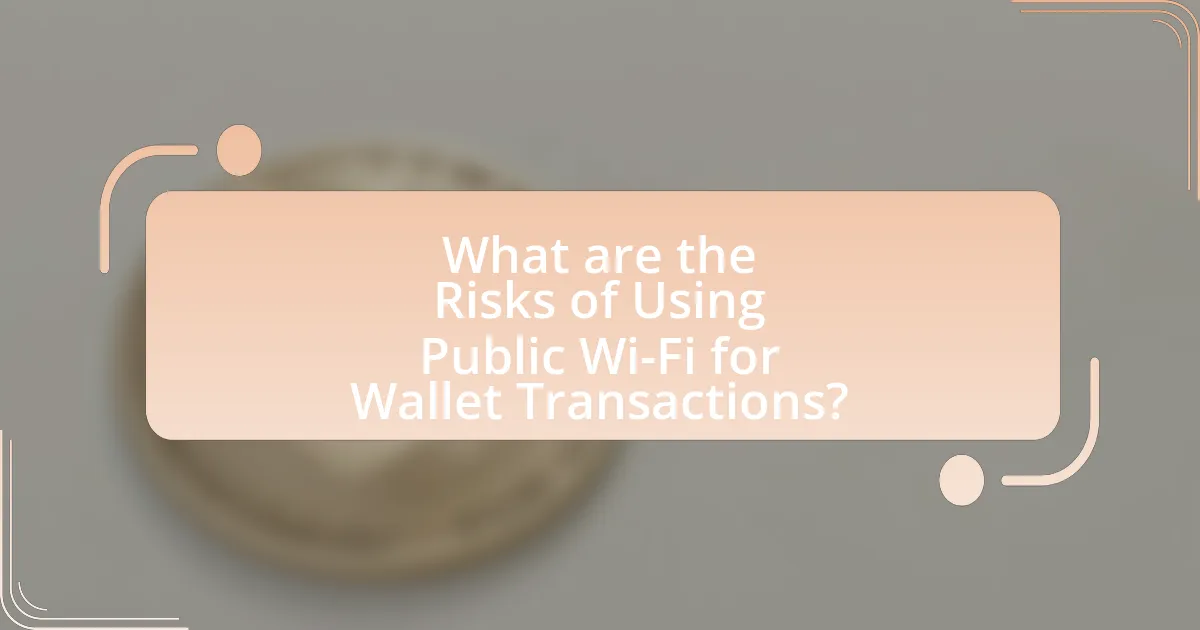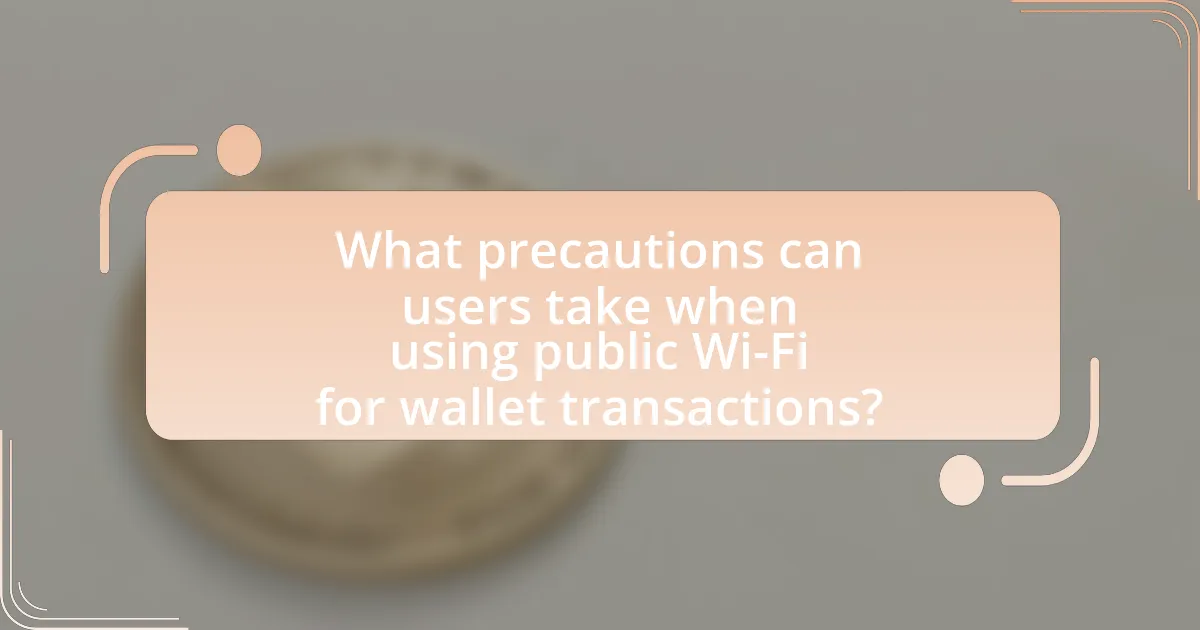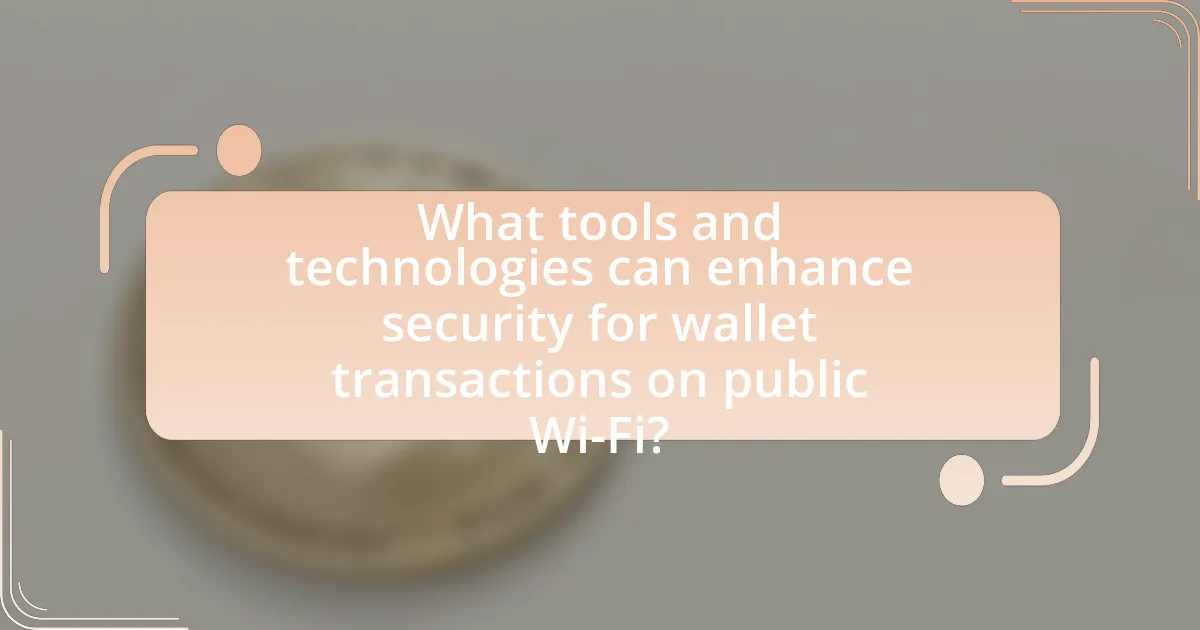The article examines the significant risks associated with using public Wi-Fi for wallet transactions, highlighting the vulnerabilities of unsecured networks. It details various cyber threats, including man-in-the-middle attacks and packet sniffing, which can lead to identity theft and financial loss. The discussion emphasizes the lack of encryption in public Wi-Fi, with studies indicating that a majority of these networks do not adequately protect user data. Additionally, the article outlines precautions users can take, such as utilizing virtual private networks (VPNs) and enabling two-factor authentication, to enhance security during wallet transactions.

What are the Risks of Using Public Wi-Fi for Wallet Transactions?
Using public Wi-Fi for wallet transactions poses significant risks, primarily due to the lack of security in these networks. Public Wi-Fi is often unsecured, making it vulnerable to various cyber threats such as man-in-the-middle attacks, where hackers intercept data being transmitted between a user and the wallet service. According to a study by the Federal Trade Commission, over 50% of consumers reported experiencing some form of identity theft linked to unsecured networks. Additionally, malware can be easily introduced on public Wi-Fi, compromising devices and stealing sensitive information. These factors collectively increase the likelihood of unauthorized access to financial accounts and personal data during wallet transactions.
How does public Wi-Fi expose users to security threats?
Public Wi-Fi exposes users to security threats primarily through the lack of encryption and the potential for malicious actors to intercept data. When users connect to unsecured networks, their data, including sensitive information like passwords and financial details, can be easily accessed by hackers using simple tools. According to a study by the Federal Trade Commission, 87% of public Wi-Fi networks do not encrypt user data, making it vulnerable to eavesdropping. Additionally, attackers can set up rogue hotspots that mimic legitimate networks, tricking users into connecting and exposing their information.
What types of attacks can occur on public Wi-Fi networks?
Public Wi-Fi networks are susceptible to various types of attacks, including man-in-the-middle attacks, packet sniffing, and rogue hotspots. Man-in-the-middle attacks occur when an attacker intercepts communication between a user and the network, allowing them to capture sensitive information. Packet sniffing involves monitoring and capturing data packets transmitted over the network, which can expose personal data. Rogue hotspots are fake Wi-Fi networks set up by attackers to lure unsuspecting users, enabling them to steal information. According to a report by the Federal Trade Commission, public Wi-Fi networks are particularly vulnerable to these attacks due to their open nature and lack of encryption, making it essential for users to exercise caution when conducting transactions.
How do hackers exploit vulnerabilities in public Wi-Fi?
Hackers exploit vulnerabilities in public Wi-Fi by using techniques such as packet sniffing, man-in-the-middle attacks, and rogue hotspots. Packet sniffing allows hackers to intercept unencrypted data transmitted over the network, capturing sensitive information like passwords and credit card numbers. Man-in-the-middle attacks occur when a hacker secretly relays and possibly alters the communication between two parties, making users believe they are connected to a legitimate network. Rogue hotspots are fake Wi-Fi networks set up by hackers to lure unsuspecting users, enabling them to harvest personal data. According to a study by the Federal Trade Commission, 70% of public Wi-Fi networks lack encryption, significantly increasing the risk of such exploits.
Why are wallet transactions particularly vulnerable on public Wi-Fi?
Wallet transactions are particularly vulnerable on public Wi-Fi due to the lack of encryption and security protocols that protect data. Public Wi-Fi networks are often unsecured, allowing cybercriminals to intercept data transmitted over the network. According to a study by the Federal Trade Commission, over 80% of public Wi-Fi networks do not use encryption, making it easy for attackers to access sensitive information such as wallet credentials and transaction details. This vulnerability is exacerbated by the prevalence of man-in-the-middle attacks, where an attacker can position themselves between the user and the network to capture data without detection.
What sensitive information is transmitted during wallet transactions?
Sensitive information transmitted during wallet transactions includes personal identification details, payment information such as credit card numbers, and transaction history. These elements are critical as they can be intercepted by malicious actors, especially when using unsecured public Wi-Fi networks. Research indicates that over 80% of public Wi-Fi networks lack adequate security measures, making them vulnerable to data breaches and unauthorized access.
How can interception of data lead to financial loss?
Interception of data can lead to financial loss by allowing unauthorized individuals to access sensitive information such as credit card numbers, bank account details, and personal identification. When data is intercepted, attackers can use this information to conduct fraudulent transactions, resulting in direct monetary loss for individuals and businesses. According to a report by the Federal Trade Commission, identity theft, often facilitated by data interception, cost consumers over $1.9 billion in 2020 alone. This demonstrates that the financial implications of data interception are significant and can have lasting effects on victims.
What are the potential consequences of using public Wi-Fi for wallet transactions?
Using public Wi-Fi for wallet transactions can lead to significant security risks, including data interception and unauthorized access to sensitive information. Cybercriminals often exploit unsecured networks to capture personal data, such as login credentials and financial information, through techniques like man-in-the-middle attacks. According to a study by the Federal Trade Commission, 70% of public Wi-Fi networks lack adequate security measures, making users vulnerable to these threats. Additionally, malware can be introduced to devices connected to public networks, further compromising the security of wallet transactions.
How can identity theft occur through unsecured connections?
Identity theft can occur through unsecured connections when cybercriminals intercept data transmitted over these networks. Unsecured connections, such as public Wi-Fi, lack encryption, making it easy for attackers to capture sensitive information like passwords, credit card numbers, and personal identification details. According to a study by the Federal Trade Commission, over 30% of identity theft cases involve the use of public Wi-Fi networks, highlighting the significant risk associated with these connections.
What legal implications might arise from compromised transactions?
Compromised transactions can lead to significant legal implications, including liability for fraud, breach of contract, and regulatory penalties. When a transaction is compromised, the party responsible for the transaction may face lawsuits from affected consumers or businesses seeking damages for financial losses. Additionally, if the compromised transaction involves sensitive personal data, the entity may be subject to data protection regulations, such as the General Data Protection Regulation (GDPR) in Europe, which imposes strict penalties for data breaches. Furthermore, financial institutions may also face scrutiny from regulatory bodies, leading to fines or sanctions if they fail to implement adequate security measures to protect against such compromises.

What precautions can users take when using public Wi-Fi for wallet transactions?
Users can take several precautions when using public Wi-Fi for wallet transactions to enhance security. First, they should use a virtual private network (VPN) to encrypt their internet connection, which protects data from potential eavesdroppers. Additionally, users should ensure that their device’s firewall is enabled to block unauthorized access. It is also crucial to avoid accessing sensitive information or making transactions on public Wi-Fi unless absolutely necessary. Furthermore, users should verify that the website is secure by checking for “https://” in the URL before entering any personal information. Lastly, keeping software and applications updated can protect against vulnerabilities that may be exploited on public networks. These measures significantly reduce the risk of data breaches and unauthorized access during wallet transactions.
How can users secure their devices on public Wi-Fi?
Users can secure their devices on public Wi-Fi by utilizing a Virtual Private Network (VPN) to encrypt their internet connection. A VPN creates a secure tunnel for data transmission, making it difficult for hackers to intercept sensitive information. According to a study by the Federal Trade Commission, using a VPN significantly reduces the risk of data breaches on unsecured networks. Additionally, users should ensure their device’s firewall is enabled and avoid accessing sensitive accounts or conducting financial transactions while connected to public Wi-Fi.
What role does VPN play in protecting wallet transactions?
A VPN encrypts internet traffic, providing a secure connection that protects wallet transactions from potential interception on public Wi-Fi networks. By masking the user’s IP address and routing data through a secure server, a VPN prevents hackers from accessing sensitive information such as passwords and financial details. Research indicates that using a VPN can reduce the risk of data breaches by up to 90%, making it a critical tool for safeguarding digital wallets when connected to unsecured networks.
How can users ensure their software is up to date for security?
Users can ensure their software is up to date for security by regularly checking for and installing updates provided by software vendors. Most operating systems and applications have built-in update mechanisms that notify users when updates are available, which often include critical security patches. According to a report by the Cybersecurity & Infrastructure Security Agency (CISA), keeping software updated is one of the most effective ways to protect against vulnerabilities that can be exploited by attackers. Additionally, users should enable automatic updates whenever possible to minimize the risk of missing important security fixes.
What best practices should users follow for safe wallet transactions?
To ensure safe wallet transactions, users should always utilize secure, private internet connections rather than public Wi-Fi. Public Wi-Fi networks are often unsecured, making it easier for hackers to intercept sensitive information. According to a study by the Federal Trade Commission, over 80% of public Wi-Fi networks lack proper security measures, increasing the risk of data breaches. Additionally, users should enable two-factor authentication for their wallet accounts, as this adds an extra layer of security against unauthorized access. Regularly updating wallet software and using strong, unique passwords further enhances protection against potential threats.
How can users verify the legitimacy of public Wi-Fi networks?
Users can verify the legitimacy of public Wi-Fi networks by checking for official network names and confirming with staff. Authentic public Wi-Fi networks often have recognizable names associated with the establishment, such as “CoffeeShop_WiFi.” Users should ask employees for the exact network name to avoid connecting to rogue networks that mimic legitimate ones. Additionally, users can look for secure connections indicated by “HTTPS” in the URL when accessing websites, as this provides an extra layer of security.
What steps should users take if they suspect a security breach?
If users suspect a security breach, they should immediately disconnect from the internet and cease all transactions. This action prevents further unauthorized access to sensitive information. Next, users must change passwords for all accounts that may have been compromised, ensuring that new passwords are strong and unique. Additionally, users should enable two-factor authentication on their accounts to add an extra layer of security. It is also crucial to monitor bank and credit card statements for any unauthorized transactions and report any suspicious activity to the financial institution. Finally, users should consider running a security scan on their devices using reputable antivirus software to detect and remove any malware. These steps are essential to mitigate the risks associated with potential security breaches, especially when using public Wi-Fi for wallet transactions.

What tools and technologies can enhance security for wallet transactions on public Wi-Fi?
To enhance security for wallet transactions on public Wi-Fi, users can utilize Virtual Private Networks (VPNs), two-factor authentication (2FA), and secure wallet applications. VPNs encrypt internet traffic, making it difficult for attackers to intercept sensitive information. Two-factor authentication adds an extra layer of security by requiring a second form of verification, such as a text message or authentication app, before completing transactions. Secure wallet applications often include built-in security features like biometric authentication and end-to-end encryption, which protect user data during transactions. These tools collectively mitigate the risks associated with using public Wi-Fi for financial activities.
What security features should users look for in wallet applications?
Users should look for multi-factor authentication, end-to-end encryption, and biometric security features in wallet applications. Multi-factor authentication adds an extra layer of security by requiring users to verify their identity through multiple methods, reducing the risk of unauthorized access. End-to-end encryption ensures that data transmitted between the user and the wallet application is secure and cannot be intercepted by third parties. Biometric security features, such as fingerprint or facial recognition, provide a convenient yet secure way to access the wallet, making it harder for unauthorized users to gain entry. These features collectively enhance the overall security of wallet applications, especially when transactions are conducted over potentially insecure networks like public Wi-Fi.
How do two-factor authentication and encryption protect transactions?
Two-factor authentication (2FA) and encryption protect transactions by adding layers of security that prevent unauthorized access and ensure data integrity. 2FA requires users to provide two forms of identification before completing a transaction, significantly reducing the risk of fraud, as it is more difficult for attackers to obtain both factors. Encryption secures transaction data by converting it into a coded format that can only be read by authorized parties, making it nearly impossible for hackers to intercept and decipher sensitive information during transmission. For instance, the use of Transport Layer Security (TLS) encrypts data sent over the internet, safeguarding it from eavesdropping. Together, these methods create a robust defense against threats commonly associated with public Wi-Fi networks, where data interception is prevalent.
What are the benefits of using biometric security measures?
Biometric security measures provide enhanced protection for sensitive information by utilizing unique physical characteristics, such as fingerprints or facial recognition, to authenticate users. This method significantly reduces the risk of unauthorized access, as biometric traits are difficult to replicate or steal compared to traditional passwords. According to a study by the National Institute of Standards and Technology, biometric systems can achieve accuracy rates exceeding 99%, making them a reliable choice for securing digital transactions. Additionally, biometric authentication streamlines the user experience by eliminating the need for complex passwords, thereby reducing the likelihood of user error and enhancing overall security.
How can users stay informed about security threats related to public Wi-Fi?
Users can stay informed about security threats related to public Wi-Fi by regularly following cybersecurity news sources and subscribing to alerts from reputable organizations. Cybersecurity firms like Kaspersky and Norton frequently publish updates on emerging threats, while government agencies such as the Cybersecurity and Infrastructure Security Agency (CISA) provide advisories on vulnerabilities associated with public Wi-Fi networks. Additionally, utilizing social media platforms and forums dedicated to cybersecurity can offer real-time discussions and insights into current threats. According to a report by the Federal Trade Commission, 25% of identity theft cases are linked to unsecured public Wi-Fi, highlighting the importance of staying informed to mitigate risks.
What resources are available for learning about cybersecurity risks?
Comprehensive resources for learning about cybersecurity risks include online courses, government publications, and cybersecurity organizations. Online platforms like Coursera and edX offer courses on cybersecurity fundamentals, while the National Institute of Standards and Technology (NIST) provides guidelines and frameworks for understanding cybersecurity risks. Additionally, organizations such as the Cybersecurity and Infrastructure Security Agency (CISA) publish reports and best practices that detail various cybersecurity threats and mitigation strategies. These resources are widely recognized and utilized by professionals in the field, ensuring their credibility and relevance.
How can users participate in community discussions on security best practices?
Users can participate in community discussions on security best practices by joining online forums, social media groups, and dedicated platforms focused on cybersecurity. These platforms often host discussions, webinars, and Q&A sessions where users can share experiences, ask questions, and learn from experts. For example, platforms like Reddit and specialized cybersecurity forums provide spaces for users to engage in dialogue about the risks associated with public Wi-Fi for wallet transactions, allowing them to exchange tips and strategies for safer practices.
What are the most effective strategies for safe wallet transactions on public Wi-Fi?
To ensure safe wallet transactions on public Wi-Fi, users should employ a virtual private network (VPN) to encrypt their internet connection. A VPN creates a secure tunnel for data, significantly reducing the risk of interception by malicious actors. Additionally, users should avoid accessing sensitive information or conducting financial transactions on public networks whenever possible, as these environments are often unsecured. According to a study by the Federal Trade Commission, over 80% of public Wi-Fi networks lack adequate security measures, making them vulnerable to attacks. Implementing two-factor authentication for wallet access further enhances security by requiring an additional verification step, thereby protecting against unauthorized access.